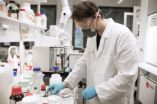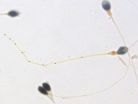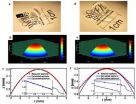(Press-News.org) Researchers at Aalto University, Finland have developed a method for producing lithium batteries that is cheaper and more environmentally friendly than previously used methods. This new process has succeeded in replacing the harmful methylpyrrolidone (NMP) solvent, which is traditionally used in the manufacturing of electrodes, with water. Removing this harmful solvent from the production process makes the production of batteries simpler and safer for employees. Production costs of batteries can be decreased by as much as 5 percent. Some of this savings comes from the reduced cost of transporting and recycling harmful chemicals and a lower risk of exposure to employees.
- Improving production methods is important as the use of batteries is rapidly increasing around the world. The increase in electric car use in particular will strongly increase the global demand and production of batteries, says Tanja Kallio, Adjunct professor at Aalto University.
A prerequisite for giving up the harmful solvent used in batteries was changing the binding agent to a water-soluble one. Finding the new binding agent, acrylic S020, was difficult because it not only had to be water-soluble but also chemically, electrochemically and mechanically ideal for this purpose.
Recently, Finnish Aalto University has achieved many significant results in battery research. Earlier this year, researchers found a way to significantly improve the durability of Lithium-ion batteries by covering the electrodes of lithium iron phosphate batteries with extremely thin protective layers, and by increasing the potential of lithium iron phosphate used as a positive electrode by doping.
INFORMATION:
An article on the study has just been published in Journal of Power Sources. Aalto University conducted this study along with University of Oulu/Kokkola University Consortium Chydenius, SPECIFIC, Sachtleben, Sun Chemicals and Walki. The research project has been funded by Tekes – the Finnish Funding Agency for Technology and the Academy of Finland.
Aalto University, Finland is a new multidisciplinary science and art community in the fields of science, economics, and art and design. The University is founded on Finnish strengths, and its goal is to develop as a unique entity to become one of the world's top universities. Aalto University's cornerstones are its strengths in education and research. At the new University, there are 20,000 basic degree and graduate students as well as a staff of 5,000 of which 350 are professors.
Researchers have made the production of batteries cheaper and safer
2012-11-13
ELSE PRESS RELEASES FROM THIS DATE:
Second most common infection in the US proving harder to treat with current antibiotics
2012-11-13
Washington, D.C.— Certain types of bacteria responsible for causing urinary tract infections (UTIs), the second-most-common infection in the United States, are becoming more difficult to treat with current antibiotics, according to new research from Extending the Cure (ETC), a project of the Center for Disease Dynamics, Economics & Policy. ETC released the research via its online ResistanceMap, an online tool created to track changes in antibiotic drug use and resistance. This year, ResistanceMap features analysis using ETC's Drug Resistance Index, a way for non-experts ...
Scientists discover how stomach cancer spreads
2012-11-13
Scientists at the University of Liverpool have found that the production of a protein that prevents the growth and spread of cancerous cells is impaired in patients with gastric cancer.
Cancer of the stomach is the second most common cause of death due to malignant disease worldwide. New research findings at Liverpool, however, could contribute to the development of future gastric cancer therapies by restoring the functions of a protein called, TGFβig-h3.
The protein is released by cells called myofibroblasts, which form part of the supporting tissue around cancer ...
How do cells tell time? Scientists develop single-cell imaging to watch the cell clock
2012-11-13
COLUMBUS, Ohio – A new way to visualize single-cell activity in living zebrafish embryos has allowed scientists to clarify how cells line up in the right place at the right time to receive signals about the next phase of their life.
Scientists developed the imaging tool in single living cells by fusing a protein defining the cells' cyclical behavior to a yellow fluorescent protein that allows for visualization. Zebrafish embryos are already transparent, but with this closer microscopic look at the earliest stages of life, the researchers have answered two long-standing ...
Powering lasers through heat
2012-11-13
This press release is available in German.
Since its invention 50 years ago, laser light has conquered our daily life. Lasers of varying wave lengths and power are used in many parts of our life, from consumer electronics to telecommunication and medicine. However, not all wave lengths have been equally well researched. For the far infrared and terahertz regime quantum cascade lasers are the most important source of coherent radiation. Light amplification in such a cascade laser is achieved through a repeated pattern of specifically designed semi-conductor layers of ...
Sperm length variation is not a good sign for fertility
2012-11-13
PROVIDENCE, R.I. [Brown University] — Perhaps variety is the very spice of life, but as a matter of producing human life, it could be the bane of existence. That's the indication of a new study in the journal Human Reproduction that found men with wider variation in sperm length, particularly in the flagellum, had lower concentrations of sperm that could swim well. Those with more consistently made sperm seemed to have more capable ones.
"Our study reveals that men who produce higher concentrations of competent swimming sperm also demonstrate less variation in the size ...
Computer memory could increase fivefold from advances in self-assembling polymers
2012-11-13
AUSTIN, Texas — The storage capacity of hard disk drives could increase by a factor of five thanks to processes developed by chemists and engineers at The University of Texas at Austin.
The researchers' technique, which relies on self-organizing substances known as block copolymers, was described this week in an article in Science. It's also being given a real-world test run in collaboration with HGST, one of the world's leading innovators in disk drives.
"In the last few decades there's been a steady, exponential increase in the amount of information that can be stored ...
Human eye gives researchers visionary design for new, more natural lens technology
2012-11-13
WASHINGTON, Nov. 13—Drawing heavily upon nature for inspiration, a team of researchers has created a new artificial lens that is nearly identical to the natural lens of the human eye. This innovative lens, which is made up of thousands of nanoscale polymer layers, may one day provide a more natural performance in implantable lenses to replace damaged or diseased human eye lenses, as well as consumer vision products; it also may lead to superior ground and aerial surveillance technology.
This work, which the Case Western Reserve University, Rose-Hulman Institute of Technology, ...
Doubling down against diabetes
2012-11-13
This press release is available in German.
A collaboration between scientists in Munich, Germany and Bloomington, USA may have overcome one of the major challenges drug makers have struggled with for years: Delivering powerful nuclear hormones to specific tissues, while keeping them away from others.
The teams led by physician Matthias Tschöp (Helmholtz Zentrum München, and Technische Universität München) and chemist Richard DiMarchi (Indiana University) used natural gut peptides targeting cell membrane receptors and engineered them to carry small steroids known to ...
New study examines how health affects happiness
2012-11-13
Fairfax, Va., (November 13, 2012) — A new study published in the Journal of Happiness Studies found that the degree to which a disease disrupts daily functioning is associated with reduced happiness.
Lead author Erik Angner, associate professor of philosophy, economics and public policy at George Mason University, worked with an interdisciplinary team of researchers from the University of Alabama at Birmingham, the University of Chicago and the University of Massachusetts Medical School. The full study is available at http://www.springerlink.com/content/k5231631755g86g2/?MUD=MP.
Previous ...
Advocacy for planned home birth not in patients' best interest
2012-11-13
Philadelphia, PA, November 13, 2012 – Advocates of planned home birth have emphasized its benefits for patient safety, patient satisfaction, cost effectiveness, and respect for women's rights. A clinical opinion paper published in the American Journal of Obstetrics and Gynecology critically evaluates each of these claims in its effort to identify professionally appropriate responses of obstetricians and other concerned physicians to planned home birth.
Throughout the United States and Europe, planned home birth has seen increased activity in recent years. Professional ...




